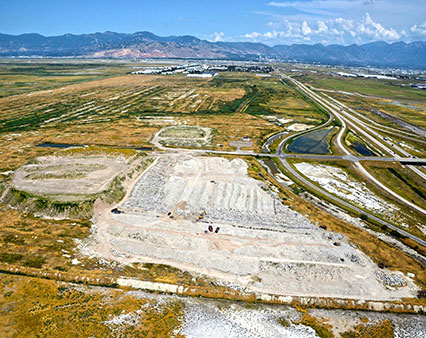The North Temple Landfill, located on the northwest side of Salt Lake City, was operated by the City from approximately 1959 to 1979 when it was closed. Due to the size of the landfill, it has historically been divided into two sites: North Temple Landfill East, also known as the Bonneville Center, and the North Temple Landfill (NTL). A number of investigations have been conducted on the property over the years by both the Environmental Protection Agency (EPA) and private landowners under the Department of Environmental Quality’s (DEQ) Voluntary Cleanup Program (VCP).
Recognizing the value of this area as a future commercial warehouse hub, the Bonneville Center was first addressed as part of the DEQ VCP by the property owner, Zions Securities, in 1998. After site assessment activities both on- and off-site, evaluation of risks and acceptance of a Site Management Plan, a Certificate of Completion (COC) under the VCP was issued in March 2000. The site was also designated “No Further Remedial Action Planned” by the EPA in July 2000. These actions helped remove the stigma associated with this portion of the former landfill and spurred development of the Bonneville Center commercial business park. Landfill material excavated from Bonneville Center was moved to the eastern portion of the North Temple Landfill as part of the cleanup.

The remaining portion of the original landfill footprint is now being addressed under the VCP. The NTL consists of approximately 770-acres, of which 620-acres are reported to contain municipal solid waste. The NTL is currently owned by the State of Utah Institutional Trust Lands Administration (SITLA).
Site assessment activities on the NTL first started in the mid-1980s as the property was investigated by the EPA. Additional assessment work was conducted by Zions Securities and Suburban Land Reserve. Currently, assessment work is being conducted both on- and off-site to understand and characterize the extent of contamination associated with the landfill.
The following is a summary of information obtained from the site characterization efforts:
- Groundwater is high in total dissolved solids and is not a source of drinking water.
- Groundwater flows west and northwest across the site.
- Groundwater contamination extends more than 900 feet off-site.
- Contaminants of concern in the groundwater include volatile organic compounds (VOCs) and metals.
- Surface soil is contaminated with lead near the former shotgun shooting range.
- Waste in the landfill includes household trash, tires and other debris.
- Subsurface soils are fine-grained and generally contain the leachate under the landfill.
- Landfill waste is the deepest on the western portion of the site.
- Contaminant concentrations are highest on the western portion of the site.
SITLA is proposing to clean up the site in a phased approach and anticipates remedial efforts will start in the southeastern portion of the site. This area contains lesser amounts of refuse and leachate and is a natural extension of the adjacent Bonneville Center commercial development. The future use of the area will be for commercial and industrial use. SITLA is currently developing a Remedial Action Plan under the VCP for this portion of the site. Field work is anticipated to begin in summer 2022.
The information gathered from the work at the North Temple Landfill and Bonneville Center is also helping other entities as they evaluate future developments in the area. One example is the Global Logistics Center, a facility north of the NTL that sat vacant until it was purchased by a private developer. To address possible soil and groundwater contamination and uncertainty in the area, DEQ was able to provide the developer an Enforceable Written Assurance (EWA) based in part on information from the assessment and cleanup. Based on the EWA, the developer was able to move forward with the construction of the commercial warehouse. Redevelopment efforts such as this address environmental contamination in a protective manner and can also bring needed jobs to the community.
Information on the North Temple Landfill:
More information on the project can be viewed via the Interactive Map or by searching “North Temple Landfill” in our document repository.
